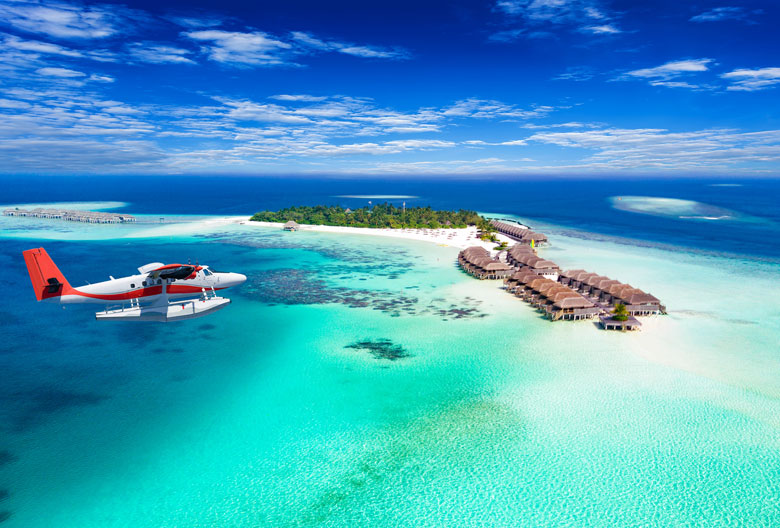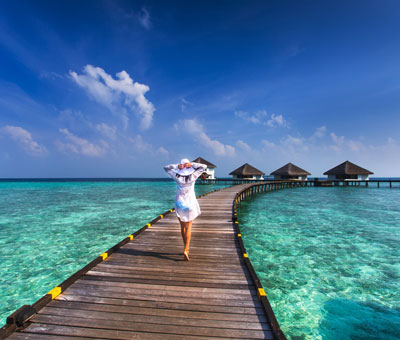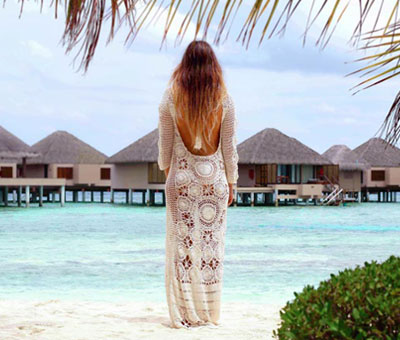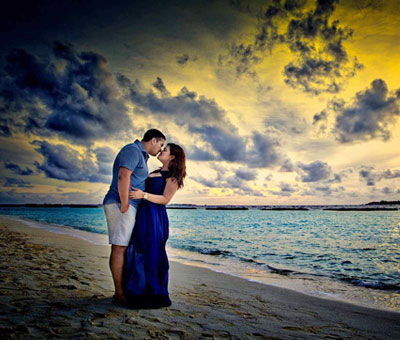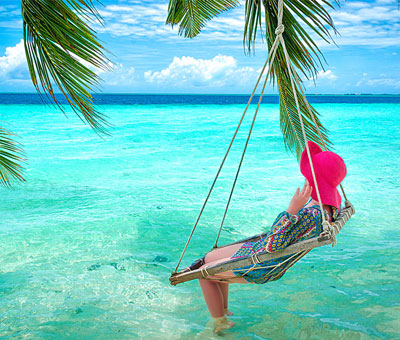Maldives as a holiday and a honeymoon destination is extremely popular with tourists from all over the world .In the recent times due to increase in the air connectivity from India and opening of a couple of resorts by the leading Indian hotel chain -Taj Hotels , The number of Indian travellers to Maldives has increased exponentially , The combination package Maldives With Sri Lanka Tour is also an option available with the tourists because of the Air Connections between Delhi , Colombo and Male .Some of the Essential information for tourists on Maldives is as below :
The Maldivian archipelago is made up of about 1,190 small, tropical, palm-covered coral islands stretching across the equator from 7° latitude north. Together with the Lakshadweep (formerly Laccadive) Islands to the north and the Chagos Islands to the south, they form part of a vast submarine mountain range, on the crest of which coral reefs have grown.
Maldives Tour Packages
Pricing and Itinerary
The islands form a double line of twenty-six natural atolls 130 kilometers (81 miles) across, stretching 823 kilometers (510 miles) from north to south. Spread across more than 90,000 square kilometers (34,750 square miles), the total land area is only 298 square kilometers (115 square miles).
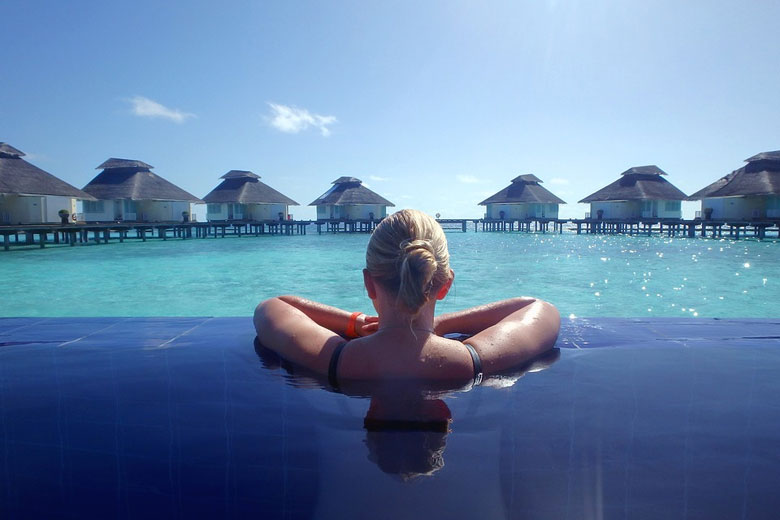
Hotels in Maldives
Every atoll (the English word “atoll” comes from the Dhivehi word athoihu) is enclosed by a coral reef cut by several deep, natural channels and a lagoon. Strong currents, swinging round with the monsoon winds, flow between the atolls.
The reef structure, peculiar to Maldives and consisting of a series of circular reefs in a line, is known as faro. Small and low-lying, the islands are rarely more than two meters (seven feet) above sea level and extremely vulnerable to surging tides and storms. Most can be walked across in ten minutes; only a few are longer than two kilometers — the longest is eight kilometers (five miles).
Although the islands are protected by coral reefs from storms and waves, inevitably some are washed away. Indeed, in 1812 and again in 1955, devastating gales destroyed many northern islands. In 1964 the island of Hagngnaameedhoo in Alifu Atoll was inundated by high waves, whiles the capital, Male, and was flooded by a severe storm in 1987.
If, as some scientists predict, the sea level continues to rise as a result of global warming, then Maldives, with its ancient and unique culture, may all be swept away within fifty years.
Exactly how the atolls were formed is still unresolved. In 1842, after studying atolls in the Pacific and Atlantic, Charles Darwin suggested that they were created when volcanic land rose from the sea and a coral reef grew around its edge.
As the volcano gradually sank back into the sea it left the coral reefs encircling a shallow water-filled lagoon. Islands developed when currents and tides swept coral debris into sand bars, which eventually were colonized by plants and trees.
Although Darwin added a postscript to say that there was something special about the Maldive islands, most scientists accept his theory. More recently, however, Hans Hass has suggested that during hundreds of thousands of years a platform of coral reefs built up on the submerged mountain chain in the Indian Ocean until they burst through the surface.Porous and unstable, the coral platform sagged in the middle, leaving only a ring of the hardest and highest coral — the rims of the atolls — where debris and sand accumulated and vegetation took hold to form islands.
These tiny specks of land separated by great stretches of water have long been a great puzzle. Just as the early history of Maldives is shrouded in mystery, so no one knows exactly how many islands there are in the archipelago. The British Admiralty chart lists some 1,100 islands, and a recent government count found 1,196. But if sand bars and coral outcrops were included the figure would be close to 2,000.

Maldives
Accurate definition is further confused by the fact that islands come and go. Some combine, others split in two and occasion-ally islets emerge from the coral reefs. A 1955 storm created three new islands in Shaviyani Atoll, while others have slowly eroded. Around 1960, for instance, the fairly large island of Feydhoo Finolhu in Male Atoll vanished through a combination of natural erosion and inhabitants taking away sand. It was later rebuilt.
To compound matters, as yet there is no agreement on what exactly constitutes an island in the archipelago: what, for instance, is the status of a large sand spit? Yet all this is part of the mystique of travelling through Maldives, where you may come across an island which has no name, is not shown on any map and has no human footprint on its shores.
Officially,’ 199 of the islands are populated. Many more show signs of past settlement, and some desert islands are used regularly by neighboring islanders for collecting firewood, coconuts and even cultivation. As a rule of thumb, when the number of males who attend the local mosque falls below forty, islanders move to a more populous island.
Climate
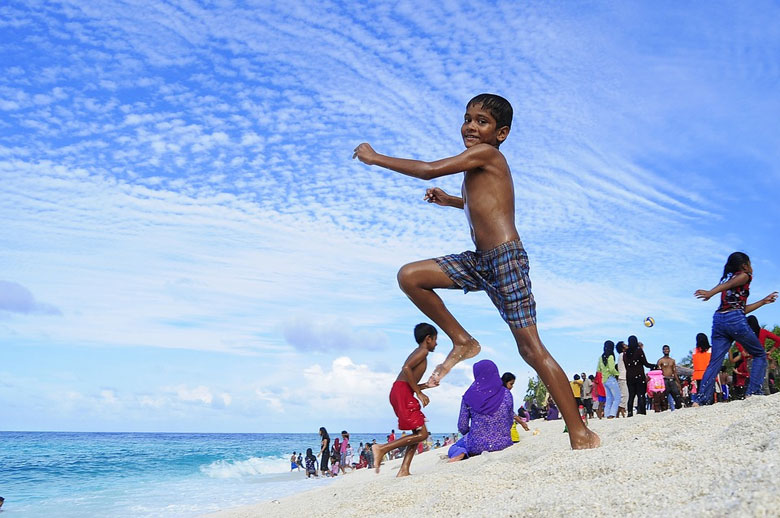
Climate of Maldives
Set in the tropics, for most of the year Maldives is hot and humid. The temperature, usually about 30°C (90°F), rarely drops below 26°C (73°F). Sea breezes take the sting from the sun except, perhaps, at midday when it reaches its zenith.
The islands, which extend latitudinally from almost one degree south of the equator to fractionally over seven degrees north, and lie scattered along and on either side of the seventy-three degree east longitudinal line, show little climatic variation.
Conveniently for sun-lovers, leisure-seekers and holiday-makers in search of an escape from the rigorous winter conditions of Europe and elsewhere, the temperatures vary little throughout each twenty-four hours, encouraging the idyllic freedom of a total outdoor life all the year round.
It is during Europe’s worst time of the year, November through to March, that the equatorial-tropical climate of Maldives exerts its maximum appeal. The tourists from all the over the world , flock the islands during this time of the year and the hotels and resorts are priced more during the period. The tourist oriented activities such as Scuba Diving , Snorkelling , Para sailing and other water sports become an important source of income for the locals. The tour package companies in Maldives also organize Island hopping tours and other local travel experiences.
As an added bonus, the indoor climate in the majority of the resorts and the hotels is gently moderated by air conditioning.
The tidal range is seldom more than a meter (three feet). The year is divided into two main seasons according to the monsoons. The north east monsoon blows from December to March when, after some initial strong winds and squalls, the sky turns an endless blue and the sun shines from six in the morning to six at night. A wet, southwest monsoon blows from April to October.
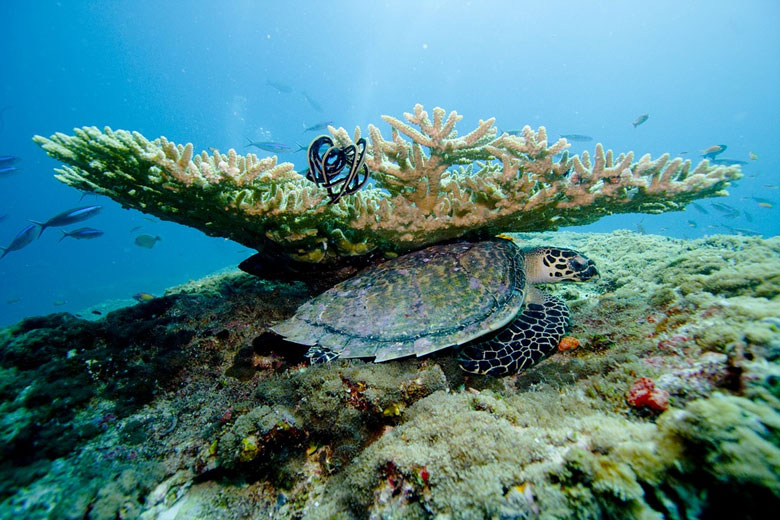
Travel information on Maldives
The average annual rainfall is 1,967 millimeters (77 inches), although it is more variable in the south. The cloudbursts are so heavy that the islands are often awash. Even in the rainy season, however, the tropical sun bursts through and quickly dries the coconut leaves and coral sand.
Maldivians, who live by the subtle changes in the weather, have developed their own complex calendar based on the rising and setting of individual stars matched with the sun or the moon.
Under the nakaiy system the Maldivians divide the year into two distinct seasons: hulhangu and iruvai. Hulhangu (the south-west monsoon), which has eighteen nakaith is a season of strong winds and stormy weather, lruziai (north-east monsoon), when the wind blows from the east, has nine nakaiy. Each nakaiy lasts thirteen or fourteen days.
The first nakaiy in the hulhangu season, for instance, is called assidha (from 8 April to 21 April) when the first rains fall. The following nakaiy are good for clearing and planting. During the sixth nakaiy, adha (from -17 June to 30 June), seafarers steer towards the middle of storm clouds as they tend to divide and give a clear path. And towards the end of the hulhangu season, fishing is generally good.
The first period of the iruvai season is mula (from 10 December to 22 December), when winds blow from the north-east and the sun shines. During this period, fishing is usually good on the eastern side and in the northern atolls.
Nothing shows as clearly as this subtle and complex calendar the Maldivians’ profound practical knowledge of nature and their careful adaptation to their environment.
Maldives Tour Packages for families and Maldives Honeymoon Packages customized by Swan Tours, Delhi, India include Accommodation at quality Hotels and Resorts, Return Airfare, Airport Transfers in Maldives (Speed Boat / Sea Plane) and much more, some of the Resorts promoted by Swan Tours in Maldives are:
- Sheraton Full Moon Resort
- Taj Exotica Resort & Spa
- Vivanta by Taj Coral reef Resort Maldives
- W Resort Maldives
- Paradise Island Resort
- Bandos Island Resort
- Holiday Inn Resort Kandooma
- Sun Island Resort
- Krumba Resort
- Lily Beach Resort Maldives
- Jumeirah Vittaveli Maldives
- Kuramathi Island Resort
- Anantara Veli Maldives Resort
- Adaaran Prestige Vadoo
- Four Seasons Maldives
